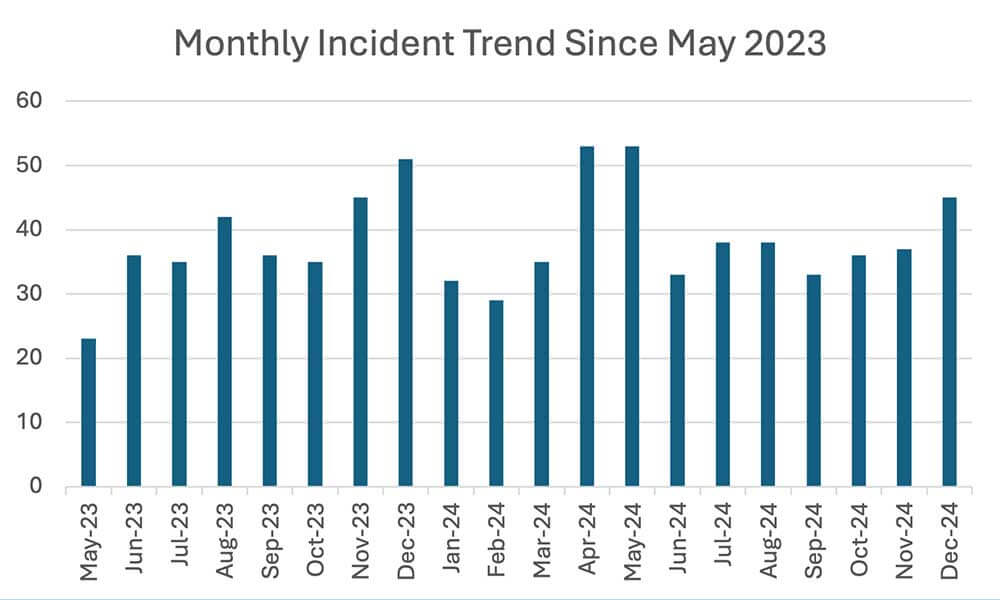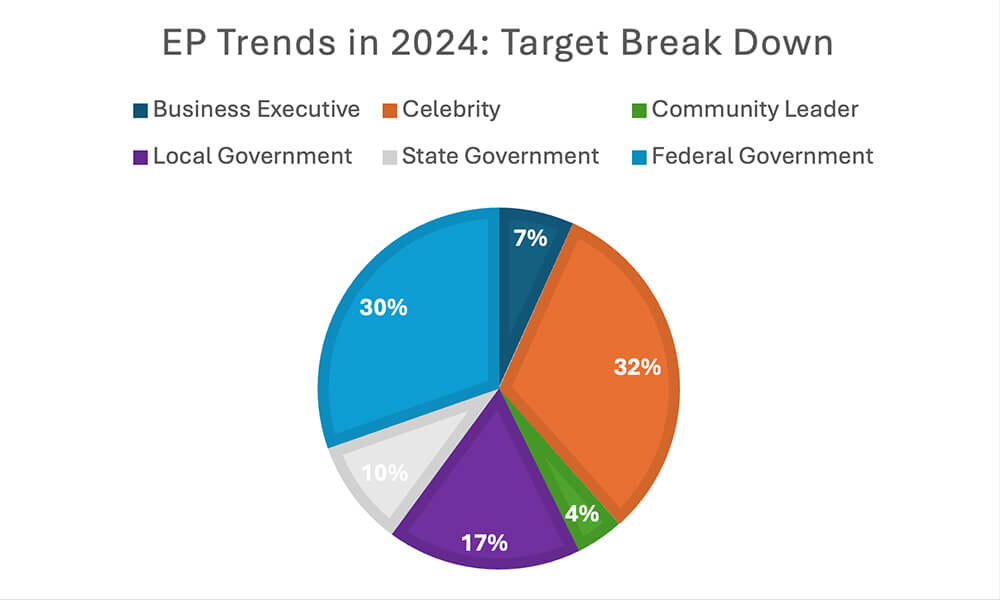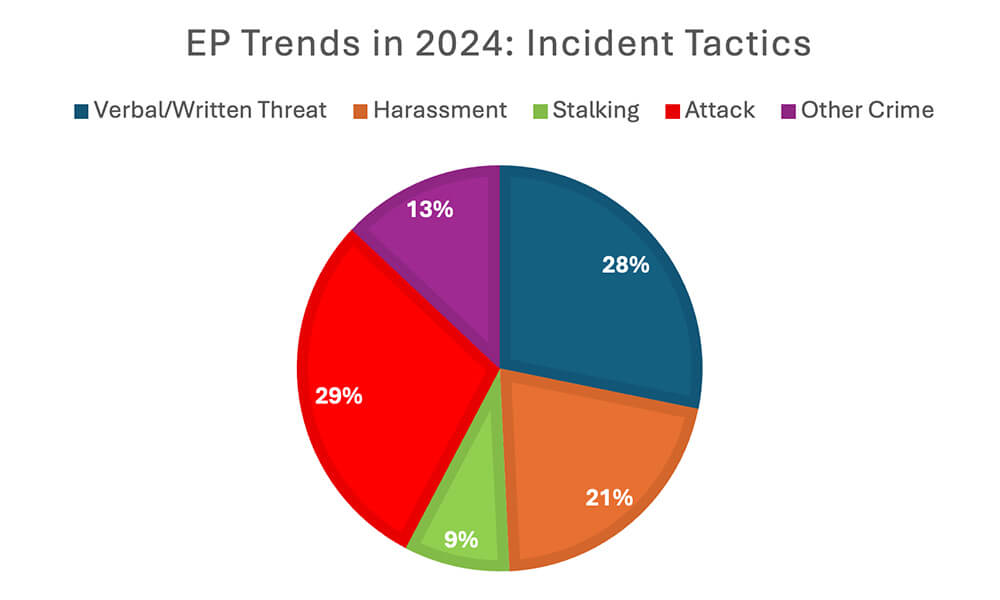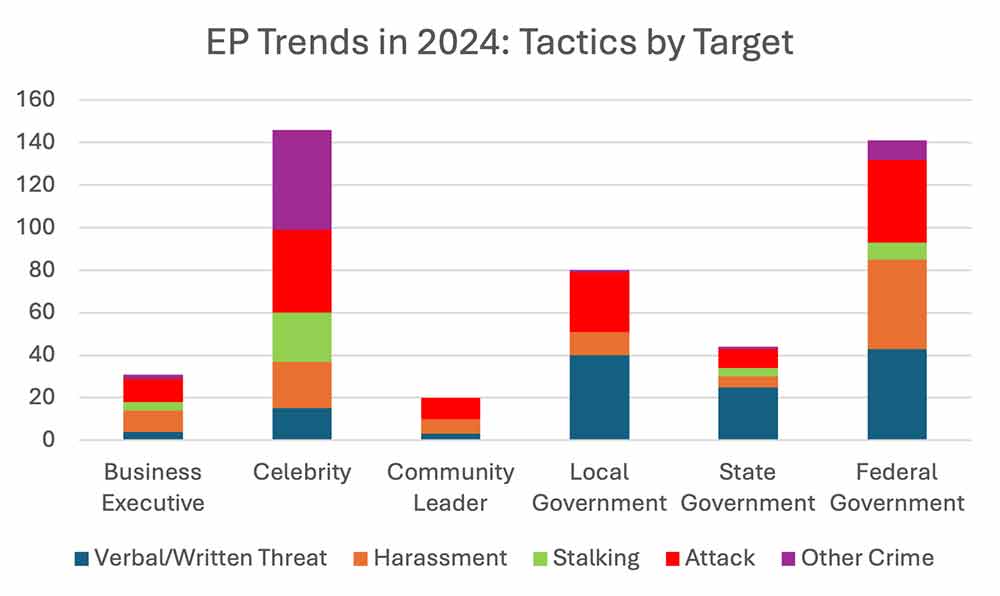
Annual 2024 TorchStone Global Executive Protection Report
2024 Annual Review of Trends in Executive Protection Threats
- A busy election year led to continued threats against government figures—particularly in the lead-up to Mexico’s election in June.
- Professional thieves are exploiting public travel schedules to target the homes of athletes and other celebrities.
- The home continued to be the most common location of incidents, emphasizing the importance of residential security.
In 2024, TorchStone recorded 462 incidents threatening high-profile individuals due to their status. While 2024 was the first full calendar year that TorchStone published monthly EP reports, trends remained consistent with 2023. We tracked 303 incidents from May to December 2023, with an average of 38 incidents per month, compared to an average of 39 incidents per month in 2024.
The December 4, 2024 murder of United HealthCare CEO, Brian Thompson, was a seminal moment for the Executive Protection industry, and concerns over executive safety remain high going into 2025. In addition to the murder of Brian Thompson and associated threats against his family, there were seven other incidents of threats against business executives in December 2024 – by far the highest number of monthly incidents targeting business executives since we began tracking in May 2023. Preliminary figures for our January 2024 report suggest that the threat against business executives remains high as social media threat influencers call for more attacks like the one that killed the United HealthCare CEO.
Targets
TorchStone monitors threats against the following target types:
Business Executives – Corporate leaders, including C-suite executives, business owners, and managers
Celebrities – To include actors, musicians, sports personalities, and social media influencers.
Federal/National Government Leaders – Elected or politically appointed leaders within national-level politics, including heads of state, legislators, and national-level administrators.
State/Regional Government Leaders – Elected or politically appointed leaders within regional-level politics, including governors, state legislators, and state-level administrators.
Local Government Leaders – Elected or politically appointed leaders within local-level politics, including mayors, city council members, and local administrators.
Community Leaders – Non-elected, prominent members of civil society who are influential at the community level, including religious leaders, journalists, and activists.
Similar to 2023, the most common targets of incidents were celebrities, followed by federal government leaders, and then local government leaders.
A historic year of elections around the world led to an uptick in violence targeting political candidates, especially in the lead-up to Mexico’s general election in June. ACLED counted 102 politically motivated assassinations in Mexico in the months leading up to June, marking Mexico’s most violent election on record.
The election cycle in the United States also contributed to sustained threats against U.S. federal lawmakers. US Capitol Police Chief J. Thomas Manger told a senate committee in December that his agency received 700 reports of threats to congress members in 2024, including 50 instances of swatting. (Most of those incidents were not publicly reported so are not reflected in our assessment.) Swatting incidents continued to cluster around holidays – particularly around Thanksgiving, 2024 when six Democratic lawmakers and four of President Trump’s cabinet picks reported swatting incidents at their residences. As political divisiveness continues, federal lawmakers will continue to face forms of threats and harassment.
Tactics
TorchStone organizes incidents within the following categories of tactics.
Verbal/Written Threat – Social media commentary, phone calls, emails, and letters that are often anonymous and rarely develop into something more serious but are valuable indicators of a grievance against an individual or group.
Harassment – Demonstrations of an actor’s capability and intent in addition to interest expressed through verbal/written threats. For example, TorchStone classifies vandalism and swatting as forms of harassment.
Stalking – As a threat actor moves into the attack cycle, they typically begin to follow or more closely study their target to determine patterns of life and identify opportunities to attack. Not all stalkers intend to attack, but their behavior makes them a more concerning threat that deserves immediate attention.
Attack – In extreme cases, a grievance can lead to physical violence, injury, and even death.
Other Crime – Financially motivated crime typically follows the same attack cycle but does not necessarily lead to physical violence.
These tactics reflect a progression along the Social Media Threat Continuum from least to most harmful, with most grievances starting at the Verbal/Written threat stage before progressing to harassment, stalking, and then attack. While “Attack” is the most common tactic that we have measured, this is likely due to the nature of reporting threats: most incidents of verbal/written threats, harassment, or stalking either go unnoticed or are not widely reported. Attacks, on the other hand, are much more noticeable and demand more public attention, and are therefore most often reported.
As practitioners of protective intelligence, we advocate for the public to pay attention to verbal/written threats, harassment, and stalking and treat them seriously, as they are indicators of potentially much more dangerous behavior. Addressing threats early on can interrupt the attack cycle or pathway to violence and prevent harm to life and property.
Robberies, home break-ins, and other forms of financially motivated property crime (registered under “Other Crime” in our database) were some of the least reported tactics overall—but were the most common crimes targeting celebrities in 2024.
Property crime often targets a high-profile individual due to the expectation of a higher payout and because their schedules are typically more publicly available.
For example, Kansas City Chiefs stars Patrick Mahomes and Travis Kelce’s homes were targeted on consecutive nights while the team was in New Orleans for a game in October. In November, Milwaukee Bucks player, Bobby Portis, said that most of his prized possessions were stolen during a burglary when the team was known to be playing an away game in Cleveland. Then, in December, the Residential Security Team at Tyler Perry’s Los Angeles home disrupted an attempted intrusion on the night that the movie producer was publicly known to be at an award ceremony in his honor.
Exploiting the public travel schedule of prominent individuals is a trend that will continue through 2025. The FBI has been circulating warnings to professional sports teams about the trend after tracking nine instances of professional athletes’ homes being burglarized while they were traveling between September and November 2024. The example of Tyler Perry highlights that professional burglary rings can apply the tactic to any high-profile individual with a public schedule—not just athletes.
Venue
TorchStone organizes venues by locations where incidents are most likely to happen.
Communication Channels – Social media platforms, email, postal mail, and other telecommunication channels that allow a degree of distance and anonymity to the author of the threat.
Public Areas – Any unrestricted area not under special security measures. This includes public streets, parks, and squares.
Restricted Areas – Any area that has additional screening and security measures that make them a harder target than public areas. This includes sporting and concert venues, airport terminals, or private clubs.
Home – Private residences
Office – Places of work, including warehouses, factories, and office buildings.
In 2024, the home remained the most common place where high-profile individuals have been targeted. This is expected, since the home is the most likely place where hostile actors will find their target or, in the case of financially motivated crimes, their target’s possessions. This was demonstrated in the examples of burglaries and attempted burglaries targeting celebrities’ homes in the section above. TorchStone continues to encourage prominent individuals to review their residential security and make sure it is adequate, as this remains the most likely point of attack for financially and ideologically motivated individuals.
The home was also the most common location for incidents of harassment, and the global protest movement in response to the Israel-Palestine conflict was a major factor in those incidents. In August, pro-Palestine protesters vandalized the apartment building where Columbia University’s Chief Operating Officer lived. Then, in October, pro-Palestine demonstrators set up an encampment outside the Cincinnati, OH home of a Jewish U.S. Representative.
Protest activity surrounding the Israel-Palestine conflict has continued despite both sides reaching a cease-fire agreement in January 2025. But targeting prominent individuals at their homes is a protest tactic that any ideologically motivated group can use. Current and future protest movements will continue to target homes to pressure and intimidate key decision-makers.
Conclusion
Intelligent and effective security solutions come from careful analysis. By reviewing trends in security incidents targeting prominent individuals, we hope that they and their security teams can make better-informed decisions about how they protect themselves and their belongings. TorchStone looks forward to continuing to provide quality threat intelligence and analysis to our clients and the general public in 2025.






